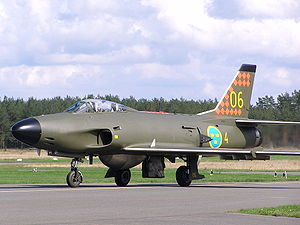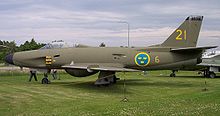Saab 32
| Saab 32 Lansen | |
|---|---|

|
|
| Type: | Jet-powered fighter aircraft |
| Design country: | |
| Manufacturer: | |
| First flight: |
3rd November 1952 |
| Commissioning: |
December 1955 |
| Number of pieces: |
452 |
The Saab 32 Lansen (German lance , military designation Saab A 32A , Saab J 32B and Saab S 32C ) is a single-engine fighter aircraft from the Swedish manufacturer Saab . The two - seat low - wing aircraft was in service with the Swedish Air Force until 1997. A total of 452 aircraft were manufactured.
development
The preliminary investigations that led to the Saab 32 began as early as 1946 when a replacement for the existing fighter-bomber, reconnaissance and night fighter aircraft was sought. However, Saab did not receive approval for the design and construction work until December 1948. Initially, a twin- engine solution was investigated, but the improved performance data of the new jet engines eventually led to Project 1150, a single-engine aircraft. Arthur Bråsjö was the project manager who first used a computer as a design aid . In application of the work by Adolf Busemann , which has since become generally known, the leading edges of the wings of this aircraft, as well as those of the conventional tail unit, received a sweep of 39 °. The Saab 32 received a retractable nose wheel landing gear with low-pressure tires and for the first time had electronic equipment that was largely developed in-house. Four prototypes were initially ordered.
Saab A 32
On November 3, 1952, the first flight took place , which was carried out by chief test pilot Bengt R. Olow. On October 25, 1953, the sound barrier was broken in the incline flight. The attack aircraft A 32A was armed with four 20 mm Bofors m / 49 cannons with 180 rounds of ammunition each and could also carry rockets and bombs. Originally only a PN-50 / A (pulse navigation radar) was on board, which is a kind of ADF . A Saab BT9C served as a reflex sight .
With a real on-board radar, which had been developed by CSF and was given the designation PS-431 / A, the machine could be used in any weather. However, only about a quarter of the Saab A 32 was equipped with a radar. One of the most important weapons was the Saab Rb 04 anti-ship missile , which was specially made for the Saab 32. A maximum of three of these weapons could be carried. The target was activated by the on-board radar.
Delivery to the troops began in December 1955, when the F 17 unit, then still in Ronneby , was equipped with the Saab 32. There it replaced the Saab T 18B . Between 1955 and 1957, a total of 284 Saab A 32A machines appear to have been delivered.
It was used in units F 17 Kallinge , F 7 Såtenäs , F 14 Halmstad , F 6 Karlsborg and F 15 Söderhamn .
Saab S 32
The Saab S 32C reconnaissance version was first flown on March 26, 1957. Instead of the weapons, she carried a total of six cameras. This version received an improved radar PS-432 / A, which had an increased range compared to the PS-431 / A. The first machines were delivered to the F 11 in Nyköping in 1960 . A total of 44 pieces of this version were made.
They were also used on the F 12 Kalmar , F 21 Luleå and F 4 Frösön .
Saab J 32
The improved version J 32B had a more powerful engine and armament, which consisted of four 30 mm Aden m / 55 cannons. A PS-42 / A, which had the option of 3D display, was used as the radar. The antenna swivel range was 60 ° to each side and + 60 ° / −30 ° up / down. The radar data and the information from the Hughes AN / AAR-4 IR system could also be displayed in the HUD (head-up display) Sikte 6A. For the first time, the pilot also received a radar display. The first flight of this version took place on January 7, 1957. Machines of the type were delivered to the F 1 - at that time still in Västerås - and the F 12 in Kalmar between 1958 and 1960 . The variant J 32D (six pieces) was a conversion to a target tow plane, and the J 32E (15 pieces) was an ECM variant of this type that was also created by conversion . A total of 120 J 32 machines were built.
It was used on the F 1 Hässlö F 12 Kalmar , the F 21 Luleå and F 4 Frösön .
Technical specifications
| Data | A 32A | J 32B | S 32C |
|---|---|---|---|
| Length [m] | 14.94 | ||
| Span [m] | 13.00 | ||
| Height [m] | 4.65 | ||
| Wing area [m²] | 37 | ||
| Empty weight [kg] | 7,438 | 8,077 | 7,520 |
| Takeoff weight [kg] | 13,600 | 13,500 | 12,500 |
| Marching speed [Mach] | 0.8 | ||
| Top speed [mach] | 0.91 | 0.93 | 0.91 |
| Dive [do] | 1.2 | ||
| Rate of climb [m / s] | 60 | 100 | 60 |
| Service ceiling [m] | 14,000 | ||
| Fuel [l] | 4100 | ||
| Operation radius [km] | 925 | 1,000 | 925 |
| Engine | RM 5A2 | RM 6A | RM 5A2 |
| Thrust [kp] with afterburner [kp] |
3,460 4700 |
4,880 6500 |
3,460 4,700 |
Armament
Guns integrated in the fuselage
- 4 × 20 mm automatic cannon Bofors Akan m / 49 (Hispano-Suiza 804) with 180 rounds of ammunition
- 4 × 30 mm automatic revolver cannon ADEN Akan m / 55 (ADEN 30) with 90 rounds of ammunition each
Ordnance up to 1,000 kg at eight external load stations
Air-to-air guided missile
- 4 × start rails for 1 × RB-24 each (Jakt-Robotsystem 24, Swedish license production of Raytheon AIM-9B "Sidewinder") - infrared controlled for short distances
Air-to-air unguided missiles
- 2 × Bofors rocket launchers, each with 19 × unguided M57 air-to-air missiles; Caliber 75 mm or 2.95 inches
Air-to-surface guided missile
- 2 × Saab RB 04C / D (Robotsystem 304) - anti-ship missile
Unguided bombs
- 8 × Minbomb m / 47 (50 kg free-fall bomb )
- 8 × Minbomb m / 61 (120 kg free-fall bomb)
- 8 × Bofors m / 60 "Lepus" (80 kg flare bomb for battlefield lighting using magnesium, fall delayed by parachute)
- 8 × m / 62 "Lepus" (75 kg flare bomb)
- 4 × Minbomb m / 42 "Hercules" (250 kg free-fall bomb)
- 4 × Minbomb m / 56 "Lyra" (500 kg free-fall bomb)
- 4 × Minbomb m / 58 "Norma" (500 kg incendiary bomb )
- 3 × Minbomb m / 50 (600 kg free fall bomb)
Additional container
- 1 × target towing container with towing bag
- 1 × EKF malfunction container "Adrian"
- 1 × EKF malfunction container "Petrus"
- 2 × containers with Philips decoy launcher electronics industry AB BOZ 3
swell
- Saab 32
- A flight through the ages. Flygvapenmuseum, 2002, ISBN 91-973957-1-4 .
- The Saab-Scania Story. Streiffert & Co, Stockholm 1987, ISBN 91-7886-014-8 .


